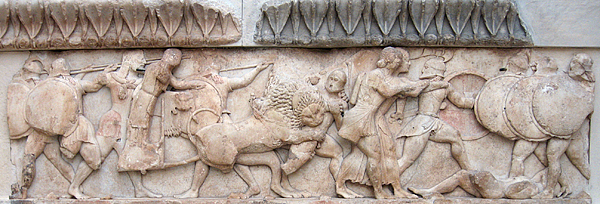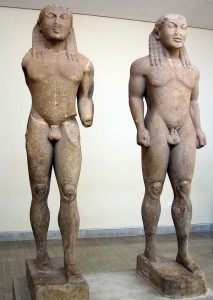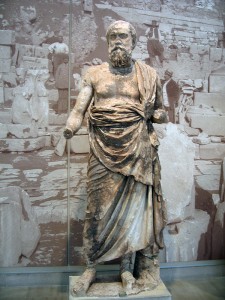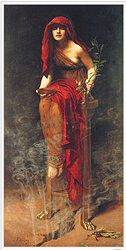I had passed the Delphi Archeological Museum several times on my way to and from the Sanctuary, but I hadn’t stopped. I knew that all the treasures that had been saved from the fires, earthquakes, mudslides, avalanches, rockfalls and plunderings of what had been one of the wealthiest places on Earth were cloistered inside those walls. And having explored as much of the Sanctuary as possible, I was ready to see if the architectural fragments and remnants of statues and gifts sent to the Oracles might reveal something about my past in Delphi.
The museum was extremely crowded that morning with wave after wave of tour groups. Slipping around the throngs in the first gallery, I entered the next room and came face to face with Cleobis and Biton, a pair of gargantuan marble statues. According to legend, the brothers pulled their mother in a wagon five miles to a festival because their oxen hadn’t returned from the fields. After feasting, they lay down to sleep in the Temple of Hera and never woke up. Whether mythical or historical figures, they represent the ideal of masculine strength and piety in the early 6th century BC. I didn’t know if it was their massiveness or if there was something more, but I gasped when I saw them and felt a twinge of recognition.
Moving ahead of the crowds, I came to a large gallery with statues lined up along each wall. One of the most impressive monuments from the Sanctuary, the 42-foot-tall Column of the Dancers, stood in the center of the room with an ornate Omphalos next to it. Even though I knew this Omphalos had once sat at the top of the column and was but another reproduction of the one that sat in the Oracle’s chamber, I wanted to ‘test’ it. I surreptitiously held my hands a few inches from its surface at the center, top and bottom as I had done with the Omphalos at the site, but there were no vibrations at all. As beautiful as this artifact was with its relief of roped netting, it felt cold and dead.
I had been avoiding one wall of statues, and when I finally turned my attention in their direction, I understood why. In the center of a multi-figure group stood a well-preserved statue of an aged man presumed to be a philosopher or a priest. I knew instantly from the depths of my being that I did not like this man. Typical of early Hellenistic art, the facial features were not idealized but instead revealed the actual characteristics of the individual. The more I looked at this statue, the more I saw ‘father’. I didn’t know if what I was sensing was coming from this lifetime or from another, but my feelings for this man were very strong and they were not good.
After walking through the remaining galleries, I decided to leave thinking I’d return when it might not be so crowded. It was another hot, sunny day and there were as many people at the site as in the museum. But I was intent on one thing only, and that was to visit the Omphalos again. Approaching the stone, I saw that I would have to wait for the crowds to pass so I could get close enough to give it my test. As before, I felt vibrations in both hands at its midpoint, not as strong as the first time, but intense enough to tell me it wasn’t just my imagination.
Strange vibrations, feelings of melancholy and fear generated by mountains, statues, and the wind . . . What did it all mean? I hadn’t had a conversation with Source since I’d left home, and I felt the time had come. I set off for a sheltered spot at the far edge of the site and found a stone bench beneath a grove of pine trees. Enveloped in the intoxicating fragrance from the trees, I thought of the Pythia sitting on her tripod inhaling the vapors that induced her prophetic state. So how about it, Source? Is there any information for me in this sacred place?




